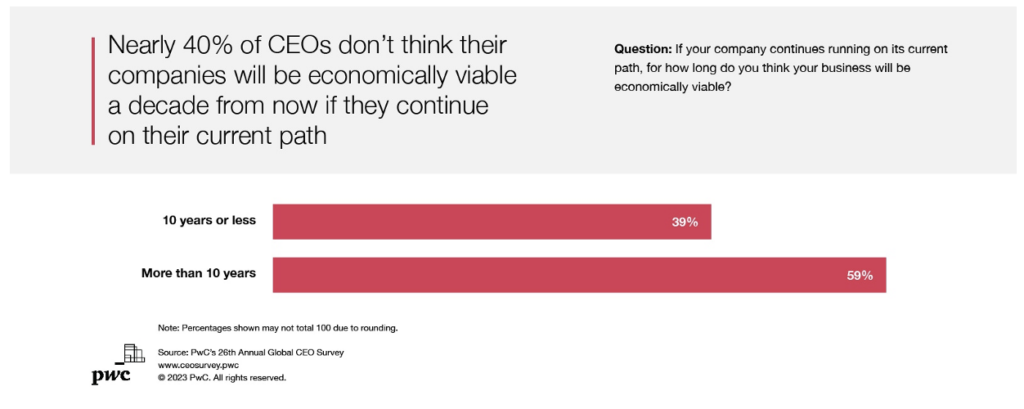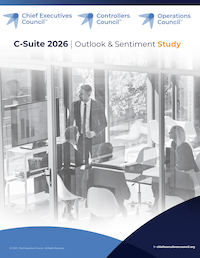Based on the latest advancements in the world of business, the adage “evolve or die” has never been more pertinent. This mantra is not just a catchy phrase but a clear reality for CEOs around the globe. As we delve into the findings till the end of Q3 of 2024, it is clear that a significant number of CEOs, almost 40%, fear that their organizations may become economically obsolete within the next decade if they persist on their current trajectories.

Source: PWC
This alarming statistic serves as a resounding wake-up call for the 4,410 CEOs from 105 countries and territories who participated in the PwC survey. These leaders acknowledge that it’s absolutely crucial to reinvent their businesses for the future.
However, they’re simultaneously grappling with immediate challenges, including a bleak outlook on global economic growth. In this article, we will help CEOs get a roadmap to success in the tumultuous years ahead, delving into key components of effective strategic planning for 2024 and beyond.
The Race for the Future
1. What’s The Half-life of Your Business?
CEOs worldwide are acutely aware of the looming specter of disruption. As mentioned above, an alarming 40% of them believe that their companies will cease to be economically viable in the next decade if they continue down their current paths. This fear isn’t confined to a single sector; it permeates industries as diverse as technology, telecommunications, healthcare, and manufacturing.
When asked about the forces most likely to impact their industry one way or another. The most prominent impact is expected to be on profitability. CEOs suggest that this may be in the form of:
- Changing customer preferences,
- Regulatory change,
- Skills shortages,
- Technology disruption,
- Transition to new energy sources,
- Supply chain disruption, and
- The potential for new entrants from adjacent industries.
These challenges are underpinned by five broad megatrends:
- Climate change,
- Technological disruption,
- Demographic shifts,
- A fracturing world, and
- Social instability.
Actionable Insights: To tackle this, CEOs need to reimagine their organizations. Like Philips, which transformed itself into a health-technology company by combining consumer insights, medical-device technologies, data analytics, and AI. This reimagination often involves tough choices about what not to do, a critical aspect of strategic planning.
2. When Will Your Company’s Climate Clock Run Out?
Climate change presents an especially urgent challenge. A majority of global CEOs expect climate change to affect their organization within 2024. This impact ranges from cost profiles to supply chains.
CEOs exposed to these risks tend to take action, but it often remains reactive. Combatting climate change requires a coordinated, long-term plan, which includes internal pricing mechanisms for carbon, a practice still absent in many organizations. 87% of global investors suggest that corporate reporting may not be truthful about sustainability claims. This has been dubbed as “greenwashing” in executive terms.
Actionable Insights: To mitigate climate risks, CEOs should break the challenge down into manageable chunks. Instead of looking at climate risk abstractly, consider specific risks like high-heat-stress days affecting critical operations. Focus on the most significant sources of emissions in your value chain and employ granular data and modeling to address them.
3. Should You Bring Your Key Business Risks Forward?
Climate change presents a significant challenge in terms of time horizon, particularly when we broaden our view to encompass a wider array of external threats to the global economy. Looking ahead to the next 12 months, CEOs find themselves most financially vulnerable to a spectrum of economic, political, and geographical risks.
These three categories of risks are pressing and attention-grabbing, often reinforcing and intensifying each other. An illustrative example can be seen in the Ukraine conflict, which led to price surges, prompting central banks worldwide to respond with interest rate hikes that dampen economic growth. However, as we shift our gaze to the medium-term outlook, spanning five years, the landscape evolves further. During this timeframe, cyber threats and climate change assume positions alongside inflation, macroeconomic volatility, and geopolitical conflicts at the forefront of CEOs’ risk concerns.
The disparity between these different time horizons raises the question of whether CEOs might find themselves unprepared for sudden challenges, mainly because of their predominant focus on immediate threats. For instance, when considering cybersecurity, it’s quite conceivable that crucial technology investments made for business purposes could inadvertently introduce vulnerabilities to cyberattacks.
Actionable Insights: To tackle cybersecurity risks, CEOs need to foster collaboration within their C-suites and promote a united front against attacks. This unity is crucial in a world where sustained, cumulative investments in risk mitigation are essential.
Today’s Tensions
4. How Much is Your Mood Affecting Your View of Tomorrow?
The state of the global economy poses the most immediate challenge for CEOs. Around 75% believe that global economic growth will decline over the next 12 months, a stark reversal from the previous year’s optimism.
This shift in sentiment raises questions about whether CEOs have swung from excessive optimism to excessive pessimism. To counteract biases, CEOs can engage their boards in discussions about critical decisions, framing scenarios about potential disasters resulting from various choices. This exercise can help boards and CEOs consider overlooked possibilities.
Actionable Insights: Recognizing the mood impact is the first step. It’s crucial to establish a culture of critical thinking and scenario planning, ensuring that the leadership team is equipped to make well-informed decisions, even in times of uncertainty.
5. How Do Your Resilience and Your Workforce Strategies Fit Together?
In response to economic challenges, CEOs are taking actions for better revenue growth. Interestingly, they’re not resorting to mass layoffs, despite cost-cutting measures. This reluctance stems from a surge in employee attrition, often referred to as the “great resignation.” CEOs expect this trend to continue, necessitating a focus on retaining top talent.
The workforce risk that concerns CEOs the most is the loss of trust in the employer. With a more mobile workforce, retaining trust is a critical success factor.
Actionable Insights: CEOs can influence employee retention by offering flexibility, fair pay, fulfilling work, and promoting an environment where employees can be their authentic selves. This is a critical determinant of success in the war for talent.
6. As Geopolitical Risks Rise, What New Contingencies Are You Preparing For?
Geopolitical shifts are impacting CEOs’ perspectives on the global economy. CEOs in various countries have differing levels of optimism about their own countries’ prospects compared to the world as a whole.
Geopolitical risks are prompting CEOs to take action, particularly by increasing investments in cybersecurity and supply chain adjustments. Among CEOs globally, 48% plan to increase investments in cybersecurity, and 38% plan to change their supply chain and sourcing strategy over the next 12 months.
Actionable Insights: To navigate these risks, CEOs must make supply chains resilient and responsive. Scenario planning and AI-enabled supply chain control towers can help organizations better understand and manage disruptions.
A Balanced Agenda
7. How Much Time and Money Are You Investing in the Future?
CEOs face the challenging task of balancing their time and resources between immediate performance and long-term adaptability. Most CEOs allocate the majority of their time to driving current operating performance and retaining employees. However, if they could redesign their schedules, they would spend more time evolving the business and its strategy to meet future demands.
Over the next three years, a majority of CEOs are planning moderate or major investments in digital transformation. CEOs are also keenly interested in artificial intelligence (AI) and the potential it holds for transforming businesses.
Actionable Insights: Striking the right balance between preserving the current business and reinventing it for the future is crucial. CEOs should allocate resources and time judiciously to ensure that the organization thrives in the long term.
8. How Central Are You to Your Company’s Reinvention?
To successfully reinvent their businesses, CEOs must empower their organizations at all levels. Survey results indicate that leaders often fail to encourage debate and dissent or tolerate small-scale failures. A culture of innovation and a willingness to challenge the status quo are crucial for deep organizational change.
Actionable Insights: CEOs can foster innovation and small-scale risk-taking by decentralizing project-level decisions and creating mechanisms to prevent small-scale projects from spiraling out of control. Encouraging a culture of experimentation can lead to more agile, innovative, and adaptive organizations.
9. What Kind of Ecosystem Are You Building?
The challenges businesses face today demand collaboration across corporate boundaries. CEOs are partnering with a wide network of collaborators to create new sources of value. Larger companies are more likely to collaborate with institutions of all types, particularly in addressing societal challenges like climate change.
Figures in Perspective: 58% of CEOs are exploring new alliances and collaborations to drive innovation and growth. Additionally, 61% of CEOs believe that their organization’s societal purpose is more important than ever.
Actionable Insights: To capitalize on these collaborations, CEOs should commit their organizations to an ESG identity and focus area, fostering trust and nurturing a corporate culture that embraces collaboration across traditional institutional lines. Building a robust ecosystem can enable organizations to leverage diverse expertise and resources to address complex challenges effectively.
Your 2024 CEO Strategic Roadmap
In conclusion, the path to success for CEOs in 2024 and beyond is fraught with challenges, but also brimming with opportunities. Navigating this landscape requires a strategic roadmap that balances immediate concerns with long-term adaptability. The dual imperative facing today’s CEOs is indeed a challenge of the first order, but it’s also an opportunity to be catalysts of innovation and solvers of societal problems, playing for the long haul.



0 Comments